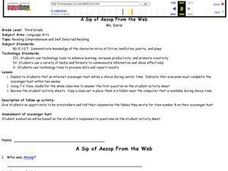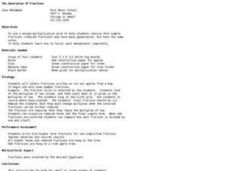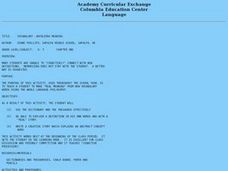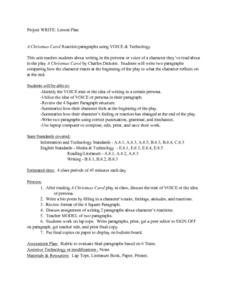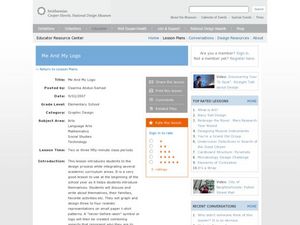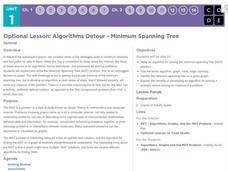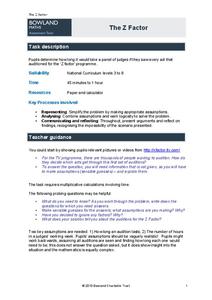Curated OER
A Sip of Aesop From the Web
Third graders answer specific questions by conducting an Internet scavenger hunt. They write their own fable after reading many different fables on the Internet. They questions that they answer are included in this instructional activity.
Curated OER
Making Your Own Master Calendar
Ninth graders discuss time demands such as homework, family, and chores that occupy their free time. They discuss how to effectively manage their time. They write important information and activities on a calendar. They develop and...
Curated OER
Place Value
While just a quick review of different ways to write a number, this could be enhanced to provide a richer exploration. Using a couple of examples, the teacher walks learners through the process of identifying and expressing numbers.
Curated OER
Assessing Presenting the Mask
Eighth graders use a software program to recreate a mask they made in art class. Individually, they write a paper describing their mask with an loose illustration. They combine the pictures of each mask into a class book for others to view.
Curated OER
It's All Greek to Me!
While the ideas for Ancient Greek research are solid, there is little detail to help make your job easier. The focus here is familiarizing your class with online databases and print resources in their school library. After direct...
Curated OER
The Generation of Fractions
Students explore the process of reducing fractions to simplest form by using a multiples grid. In this simplest form lesson, students pull different fractions out of a bag and then consult their grid to discover all the multiples that...
Curated OER
Phases of the Moon
Students read "The Moon Seems to Change" and conduct an experiment with oranges to demonstrate the phases of the moon. They write about the experiment and describe each phase of the moon.
Curated OER
All Around the Neighborhood - Part 3
Second graders illustrate the roles, responsibilities, and skills of community members and write a paragraph that summarizes the importance of those roles, responsibilities, and skills. They are asked: "What is a role?" Students are...
Curated OER
Vocabulary - Unfolding Meaning
Students write the "word for the day" onto a note card. They add a definition, discuss in class and file the card in their own metal box. At the end of the week students play a game with the words from that week.
Curated OER
I Dream in Pictures and Words (Day 1)
High schoolers are introduced to the art of Rene Magrritte and Marc Chagall. Using the internet, they discover the characteristics of Surrealist artists and write a paper. They share their findings with the class and answer discussion...
Curated OER
Evaluating Expressions Using Tiles
Sixth graders are shown a variety of algebraic equations. In groups, they use tiles to represent each expression in the equations. To end the instructional activity, they solve story problems with one and two unknown variables....
Curated OER
Photography Narratives
Students write a narrative corresponding to a photo. They create a background story based on the person in their picture and share it with the class.
Curated OER
A Christmas Carol Reaction
Eighth graders explore writing in voice. They read and discuss A Christmas Carol and the trait of voice in writing. They write a bio poem about one of the characters and his traits, feelings, attitudes and reactions. They write their...
Curated OER
All About Me Poem
Eighth graders write a poem that introduces them to their class. In this poetry writing lesson, 8th graders use the format for the 'All About Me Poem" to write a poem about themselves and use it as get-to-know-you activity.
Curated OER
Me and My Logo
Students design their own emblem. In this introduction instructional activity, students get to know one another by designing an emblem that combines symbols that represent themselves. They express themselves to their classmates.
Curated OER
Drafting the Declaration of Independence
Students working in small groups to compare and contrast the rough draft of the Declaration of Independence written by Thomas Jefferson with the final version. They list the differences and decide on why the changes were made.
Curated OER
Ratifying the Constitution
After a lecture on ratifying the Constitution, this worksheet would be perfect to reinforce your government (or U.S. History) students' new knowledge. The activity contains ten knowledge-level and comprehension-level questions. This...
Code.org
Functions and Top-Down Design
Let me break it down for you! Introduce your class to a way of breaking up a complicated task into its component pieces. Individuals draw a complex figure using JavaScript and then break it down to help determine the...
Santiago Canyon College
Taking Notes for Science Class
Provide young scholars with the tools they need to succeed with this reference on the Cornell note-taking strategy. By breaking the content of lessons into main ideas, supporting details, and overall summaries, students are...
Smarter Balanced
How We Learn
What's the best way to learn the elements of the periodic table? The inventions of Thomas Edison? Patience? To prepare for the performance task assessment on how people learn, class members share ideas about ways to learn in a variety of...
Code.org
Algorithms Detour - Minimum Spanning Tree
This optional lesson introduces the class to the idea of a minimum spanning tree. The activity focuses on determining an algorithm that will find the most efficient path in a network to transfer data.
K12 Reader
Step by Step Instructions
Here's a worksheet that not only provides readers with information about crafting step-by-step directions for a science project, but also serves as a reading comprehension exercise.
Bowland
The Z Factor
Young mathematicians determine the number of hours it would take judges of the "Z Factor" television talent show to watch every act. Participants make estimates and assumptions to solve the problem.
Nuffield Foundation
Microscale Investigations of Catalase Activity in Plant Extracts
Use indirect measurements to monitor metabolic activity in plant cells. Scholars understand that cells with a higher metabolic rate have a higher concentration of catalase enzyme. They use this information to compare metabolic rates of...
